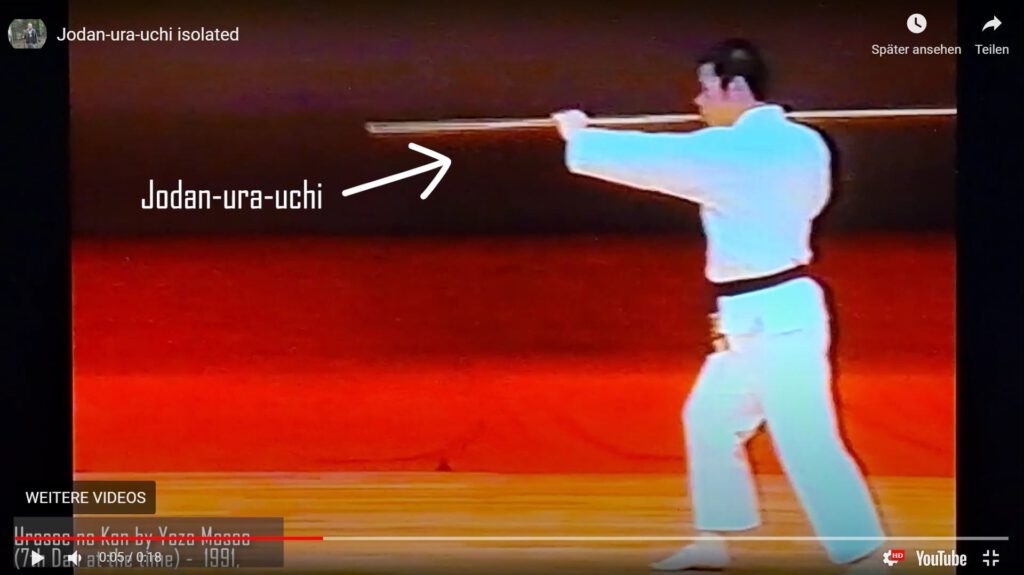Most people are not aware that Akamine Eisuke created handwritten descriptions of every kata (1982/83, personal archive of this author). There was a collection that was given to dojo directors, which included all kata up to 5th dan, but the higher kata were also described meticulously.
In the descriptions of the bo kata, the term “Jodan-ura-uchi” appears in 141 (!) instances, each time followed by Shomen-uchi. It looks like this:
The person in the video is Yoza Masao Sensei in 1991. At that time, he was a 7th Dan under Akamine Eisuke. Actually, already 45 years ago – in 1976 – Yoza served as the instructor of the Shimbukan as the General Headquarter of the Ryukyu Kobudo Hozon Shinkokai, as is officially stated in the 1976 brochure of the Ryukyu Kobudo Hozon Shinkokai. I received a little instruction from Yoza at the old Shimbukan honbu btw. Last time I saw him was after a directors’ meeting in 2011.
Now, as regards this technique, I have often heard that “this is just a kamae!” but this is historically inaccurate. As I already mentioned, the Jodan-ura-uchi followed by Shomen-uchi is found in 141 instances in the bo kata descriptions of Akamine Eisuke, that is, basically every single time before the Shomen-uchi. Obviously, as exemplified in the video above, the technique was actually performed like that.
Here is a list of the 141 instances of Jodan-ura-uchi followed by Shomen-uchi, broken down to each kata:
| Shushi no Kon Sho | 7 |
| Sakugawa no Kon Sho | 8 |
| Shushi no Kon Dai | 9 |
| Sakugawa no Kon Dai | 11 |
| Yonegawa no Kon | 13 |
| Shirotaro no Kon | 9 |
| Chinen Shikiyanaka no Kon | 20 |
| Choun no Kon | 17 |
| Chatan Yara no Kon | 9 |
| Soeishi no Kon | 24 |
| Urasoe no Kon | 14 |

jodan-ura-uchi
Well, in the original descriptions, on the pages for Shushi no Kon Sho, at the point of the Jōdan-ura-uchi there was a handwritten note added: “this is the meaning of the bunkai.” That is, the Jōdan-ura-uchi is the application of the technique. However, in the copy of the kata descriptions, at some later date, a handwritten note was added, saying that this (Jōdan-ura-uchi) was “only a kamae.” Like many others, I was told this explanation too at the Shimbukan. However, no such note was ever added to other entries.
In any case, today this technique is done a little bit more slanted downwards, and a new term was used by a friend (7th dan Shimbukan), namely “gyaku-shomen-uchi,” or reverse front strike. This term gyaku-shomen-uchi is nowhere to be found in Akamine Eisuke’s descriptions so it is probably a new invention to give a name to the transformed technique.
It should be added that neither Miki in 1930 nor Taira Shinken in 1937 and 1964 described the Jodan-ura-uchi, but they referred to it as a preparation for the Shomen-uchi. Accordingly, the Jodan-ura-uchi interpretation was probably made by Akamine Eisuke himself.
You may think, it is not a big thing, but 141 instances of a an applied technique changed to a mere kamae (preparatory posture) is a massive change!
In any case, I think it is an interesting small case study since it not only shows a transformation of the Jōdan-ura-uchi, but also a transformation in terminology, excecution, and combative meaning.
See some more examples below:
© 2021, Andreas Quast. All rights reserved.
